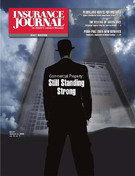After warming up the new Caddy, defrosting the windows, and buckling up the seat belts, what could possibly be left to do before hitting the road to acquisition?
To grow agency business by acquiring other firms, following a sequence of well-defined steps increases the chance of success.
The first part of this article, published in Insurance Journal’s Dec. 6 issue, discussed prospecting, considering cultural fit with prospective firms, and assembling a team to evaluate potential purchases. But too many agency owners just grasp at opportunities without thoroughly reviewing their firm’s strengths and the needs of the marketplace. This evaluation is where the rubber meets the road.
Examine the motivation
A strategic view of the agency, its impediments, and desired area of growth is essential. To get a clear picture of the firm’s place in the market, the agency should perform a SWOT analysis to determine its strengths, weaknesses, opportunities and threats.
Strengths. What are the highest-performing lines and strongest industry relationships?
Weaknesses. Where could the agency improve, either in personnel, programs or operations?
Opportunities. Have changes by agency competitors or the regional business climate left a hole in coverage? Where can efficiency gains help?
Threats. Who’s breathing down the agency’s neck? What might happen to sabotage agency plans?
Before effectively executing an acquisition, the agency must first remediate its own inefficiencies, jettison unprofitable markets and products, and establish a growth plan.
The SWOT analysis also will help to create an acquisition profile that will define strategic motivations and narrow the search. The analysis will also help prioritize needs. It may show that a product specialist is needed to fill a gap, or that territorial expansion is the best route. The agency owner may decide to gain synergy by combining with an agency much like their own, or to expand the current product mix. Maybe the agency needs access to a competing firm’s people. The agency might be forced into acquisition mode just to stay competitive.
Whatever the motivation, recognize that most acquisition candidates will not meet all stated criteria. It is also recommended that the agency use a formal evaluation matrix, further taking the guesswork out of the choice.
Buyers must have a thorough understanding of the dynamics of the market and how those dynamics affect the pricing of agencies up for sale. For instance, in many markets there are well-funded ventures vying for the same targets. This might drive prices up. But unless a buyer goes into the market knowing the pricing rationale, they may end up with unrealistic cost expectations, or might find themselves settling for a “fire sale” target. In either case, they’d be buying into disaster.
Capitalize the expansion
Perhaps the most disturbing mistake often made by acquiring agencies is to believe they can buy another agency purely on an installment basis, offering a note to the seller or retention of the business they are slowly taking over. This is simply an unrealistic approach. In today’s marketplace, 90 percent of the contemplated value is paid up-front. An installment offer cannot compete.
It is equally important that agency owners evaluate the “cost of capital” component prior to proceeding with a potential purchase. Debt service or financial impact should be carefully modeled against market trends so that the agency owner is fully apprised of what to expect from near and long term results of a combined entity. It is critically important to weigh economies of scale when combining businesses, as well as to consider potential risks that the market and cultural barriers may present.
The financial impact of integration also needs to be seriously reviewed to fully anticipate the capital needs. Careful planning and integration timing will provide the basis for a sound financial decision.
Ultimately, the acquiring agency’s owners may need to forgo immediate “perceived” gains, and take a slower route to integrating the acquired firm. The true profit will only be revealed when true integration has taken place.
All of these steps lead up to the ultimate safety net that must be part of any transaction: due diligence. Investigation of the seller’s business prior to purchase is absolutely vital. Take a close look at:
Typically a thorough review of all relevant business documents must be done to ensure that there are no salient risk issues. Then you must consider how to manage issues like customer attrition and brand integration that are naturally part of the acquisition process.
Ready? Don’t wait
If the analysis shows a purchase that works, don’t sit back and wait. There are two things that always kill a deal: greed and time.
Timely execution will put momentum on the acquiring agency’s side and will place the deal in a positive light to staff, customers and the industry, not to mention the staff and clients of the firm being acquired. Even if acquirer makes all the turns at full speed, the process takes six months on average, and can easily take nine months.
During this time, both parties need to stay committed to the complete execution of the transaction. This is easier said than done. Countless distractions could cause either party’s attention to wander, which would slow the momentum and raise unanticipated problems.
It is equally risky to go through with the purchase, and then sit back, relax and say “the deal is done.” That’s human nature. But it is often said that anyone can do a deal, but not everyone can make it effective. Statistics support that view. Shareholder value usually becomes depleted by an acquisition–and the fallout is not fully visible until years in the future.
That’s why the “transaction” truly requires action that transcends the sale itself. A complete purchase transaction includes integration, cultural assimilation and execution of the long term business strategy created when the purchase was contemplated. Only when all these steps are done in a cohesive environment can real success be measured. You may be enjoying that Cadillac’s new-car smell, but don’t let it be a distraction from keeping all eyes on the road ahead.
Steven S. Wevodau, managing principal of WFG Capital Advisors ( www.wfgca.com ) has extensive experience in mergers, acquisitions and strategic consulting. WFG Capital Advisors provides financial solutions to the insurance and financial services industry. He may be reached at (717)
780-7802 or by e-mail: swevodau@wfgca.com.
Topics Mergers & Acquisitions
Was this article valuable?
Here are more articles you may enjoy.


 WTW to Acquire Newfront in Deal Worth Up to $1.3B
WTW to Acquire Newfront in Deal Worth Up to $1.3B  Chubb, The Hartford, Liberty and Travelers Team Up on Surety Tech Launch
Chubb, The Hartford, Liberty and Travelers Team Up on Surety Tech Launch  California Again Delays Wildfire Protection Rules for Homes
California Again Delays Wildfire Protection Rules for Homes  Brookfield Targets Global Dominance in P/C Insurance Coverage
Brookfield Targets Global Dominance in P/C Insurance Coverage 


